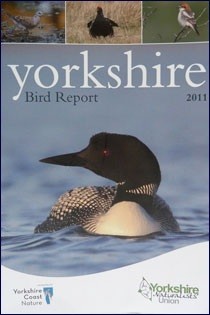Yorkshire Bird Report 2011

As one would expect, the bulk of the report is taken up by species accounts. These contain a wealth of information, but rather than a simple list of records or site names, the accounts are intelligent and insightful. The size of the county and its traditional subdivision into five Watsonian vice-counties means that there is always a risk that accounts could occasionally feel artificially glued together, but in most cases this is avoided by the authors and/or editors. Many accounts are supplemented by summary statistics from both the Breeding Bird Survey and Wetland Bird Survey. The accounts are peppered with some excellent artwork, while photos are contained in a separate 'Gallery' section, as well as being used at the start of individual sections (my favourite being the stunning shot of Purple Sandpipers fleeing the waves — surely at Filey?) The report ends with a fascinating review of Hen Harriers in the Yorkshire Dales, followed by an extensive report on ringing recoveries.
Some of the highlights of 2011 were four territorial pairs of Common Cranes (albeit none successfully raising young), and one fantastic/infuriating Sandhill Crane (depending on exactly where you were along the coast on 29th September!) There were further welcome increases in Black Grouse in the Dales, while dedicated survey effort revealed an incredible 336 singing Quail. Further depressing, but predictable, declines were reported for Nightingale (one record, no longer breeds) and Turtle Dove (Spurn recording its worst year for passage birds since 1959). The accounts are full of interesting snippets; I was struck by the finding that the mean altitude of Merlin nest sites in the North York Moors is increasing at 30 metres per year.
In recent years, I've heard some people ask what the purpose of county bird reports is. Indeed, I admit I have sometimes wondered this myself. To some extent, this report has rekindled my faith. If a county report becomes little more than a bare list of records, then it is difficult to argue that it adds anything over and above an electronic database. But a report like this one, which cogently analyses and summarises the records for the year, is a review of the county's birds that will stand as an important comparative and interpretative document in years to come. Not only that, but it seems clear that a report such as this can ask questions and can drive the quest for further knowledge and even local conservation action. The report is testament to a real dynamism amongst Yorkshire's birders today. Moreover, the report represents an enormous amount of work by Craig Thomas, Jill Warwick and their team, not only in amassing and condensing this mass of information but also in managing such a dispersed team of Yorkshire's bird experts from right across the county. I highly recommend it.
Published by the Yorkshire Naturalists’ Union, 248 pages, colour photographs. £12.00 plus £2.00 p&p. Available from Jill Warwick jill@swland.co.uk 01765 602 832; cheques to be made payable to Yorkshire Naturalists' Union.
Yorkshire Naturalists' Union website


